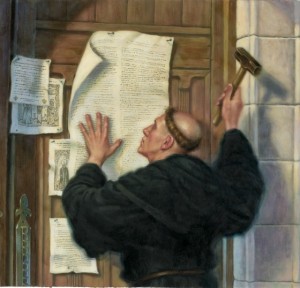 From Justin Taylor’s 1517, a 33-year-old theology professor at Wittenberg University walked over to the Castle Church in Wittenberg and nailed a paper of 95 theses to the door, hoping to spark an academic discussion about their contents. In God’s providence and unbeknownst to anyone else that day, it would become a key event in igniting the Reformation.
From Justin Taylor’s 1517, a 33-year-old theology professor at Wittenberg University walked over to the Castle Church in Wittenberg and nailed a paper of 95 theses to the door, hoping to spark an academic discussion about their contents. In God’s providence and unbeknownst to anyone else that day, it would become a key event in igniting the Reformation.
Carl Trueman—who wrote his dissertation on Luther’s Legacy, teaches on Luther’s life and theology, and is writing a book on Luther on the Christian Life—answered some questions for us.
Had Luther ever done this before—nail a set of theses to the Wittenberg door? If so, did previous attempts have any impact?
I am not sure if he had ever nailed up theses before, but he had certainly proposed sets of such for academic debate, which was all he was really doing on October 31, 1517. In fact, in September of that same year, he had led a debate on scholastic theology where he said far more radical things than were in the Ninety-Five Theses. Ironically, this earlier debate, now often considered the first major public adumbration of his later theology, caused no real stir in the church at all.
What was the point of nailing something to the Wittenberg door? Was this a common practice?
It was simply a convenient public place to advertise a debate, and not an unusual or uncommon practice. In itself, it was no more radical than putting up an announcement on a public notice board.
What precisely is a “thesis” in this context?
A thesis is simply a statement being brought forward for debate.
What was an “indulgence”?
An indulgence was a piece of paper, a certificate, which guaranteed the purchaser (or the person for whom the indulgence was purchased) that a certain amount of time in purgatory would be remitted as a result of the financial transaction.
At this point did Luther have a problem with indulgences per se, or was he merely critiquing the abuse of indulgences?
This is actually quite a complicated question to answer.
First, Luther was definitely critiquing what he believes to be an abuse of indulgences. For him, an indulgence could have a positive function; the problem with those being sold by Johann Tetzel in 1517 is that remission of sin’s penalty has been radically separated from the actual repentance and humility of the individual receiving the same.
Second, it would appear that the Church herself was not clear on where the boundaries were relative to indulgences, and so Luther’s protest actually provoked the Church into having to reflect upon her practices, to establish what was and was not legitimate practice.
Was Luther trying to start a major debate by nailing these to the door?
The matter was certainly one of pressing pastoral concern for him. Tetzel was not actually allowed to sell his indulgences in Electoral Saxony (the territory where Wittenberg was located) because Frederick the Wise, Luther’s later protector, had his own trade in relics. Many of his parishioners, however, were crossing over into the neighboring territory of Ducal Saxony, where Tetzel was plying his trade.
Luther had been concerned about the matter of indulgences for some time. Thus, earlier in 1517, he had preached on the matter and consulted others for their opinions on the issue. By October, he was forced by the pastoral situation to act.
Having said all that, Luther was certainly not intending to split the church at this point or precipitate the Holy Roman Empire and the Papacy into conflict and crisis. He was simply trying to address a deep pastoral concern.
Was Luther a “Protestant” at this point? Was he a “Lutheran“?
No, on both counts. He himself tells us in 1545 that, in 1517, he was a committed Catholic who would have murdered—or at least been willing to see murder committed—in the name of the Pope. There is some typical Luther hyperbole there, but the theology of the Ninety-Five Theses is not particularly radical, and key Lutheran doctrines, such as justification by grace through faith alone, are not yet present. He was an angry Catholic, hoping that, when the Pope heard about Teztel, he would intervene to stop the abuse.
How did that act of nailing these theses to the door ignite the Reformation?
On one level, I am inclined to say “Goodness only knows.” As a pamphlet of popular revolution, it is, with the exception of the occasional rhetorical flourish, a remarkably dull piece of work which requires a reasonably sound knowledge of late medieval Catholic theology and practice even to understand many of its statements. Nevertheless, it seems to have struck a popular chord, being rapidly translated into German and becoming a bestseller within weeks. The easy answer is, therefore, “By the providence of God”; but, as a historian, I always like to try to tie things down to some set of secondary or more material causes.
Certainly, it was used in a way that appealed to popular anti-clericalism, resentment of the Roman curia, and a desire to stop money flowing out of German speaking territories to Rome. Yet, even so, the revolutionary power of such a technical composition is, in retrospect, still quite surprising.
For those today who want to read the 95 Theses, what would you recommend?
The place to start is probably Stephen Nichols’s edition (with an introduction and notes).
Nevertheless, if you really want to understand Luther’s theology, and why it is important, you will need to look beyond the Ninety-Five Theses. Probably the best place to start would be Robert Kolb and Charles P. Arand, The Genius of Luther’s Theology.
